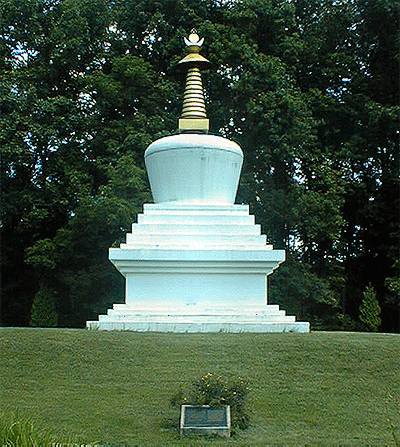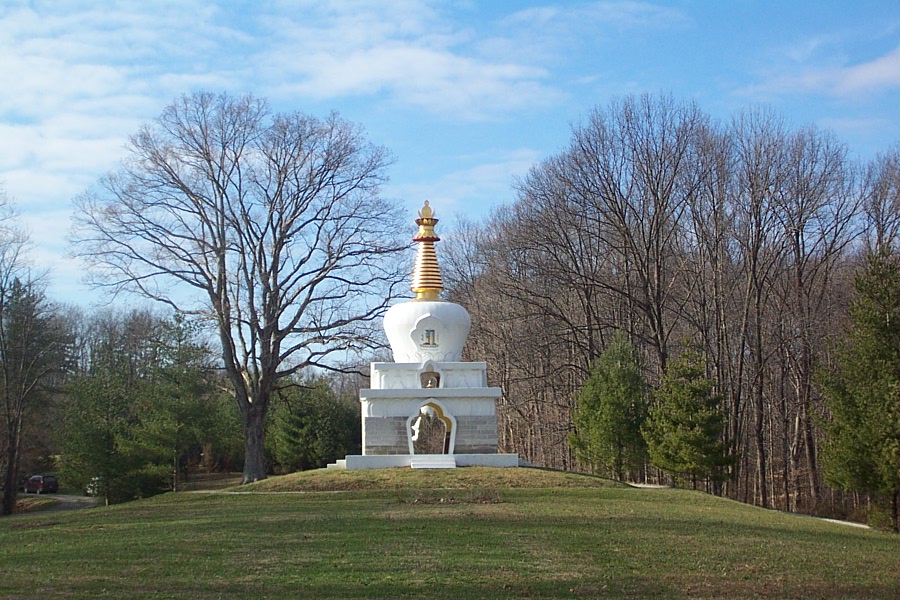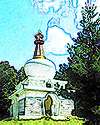| Jangchub
Chorten | Kalachakra Stupa
|
The
Jangchub Chorten

Buddhist monks dedicated a traditional Tibetan Chorten in a ceremony
at the site on June 6, 1987. Later, in September of the same
year, His Holiness the Dalai Lama consecrated the Jangchub Chorten
not only as a reminder of the Tibetans' cause but also as a monument
of hope to all people who seek world peace and justice.
The following dedication is
inscribed on the plaque in front of the Janchub Chorten.
|
Dedication of the Chorten
In recent times, conflict and
aggression throughout the world have visited death and destruction
on countless innocent people. This has been especially true in
Tibet, a land devoted to religion, where more than one million
people have perished since 1959 when the Chinese Army occupied
the country. Even now as the devastating occupation continues,
Tibetan lives are threatened, as the vast majority of Tibetan
people are subject to policies whose ultimate aim to bring an
end to their way of life.
This Chorten
stands before the people of the world who love justice and peace,
as testimony to the miseries suffered by the Tibetan people and
to the justness of their cause. In that sense, it stands also
as a memorial to all people who have similarly suffered. may
it remain so for all times.
Our hopes
as Tibetans-- and the hopes of people everywhere to dwell in
nonviolence, peace and security-- will together endure as inward
supports for all our spirits. |
THE CHORTEN expresses a symbolic
significance, which binds the component parts of the monument
into a meaningful whole.
The three main elements of
the stupa are the base, dome and crowning parts. The shape of
the monument explicitly resembles the body of the Buddha and
evokes his physical presence. The base represents his throne;
the four steps, his legs crossed in the lotus position; the dome,
his torso; the square, his eyes; and the spire, his crown.
The stupa first and foremost
represents the enlightened mind, and a more complex symbolism
exists on this second level of interpretation. Each of the four
steps corresponds to one of the four following groups; the perfect
abandonments, the four legs of miracles, the five powers and
the four close contemplations.
The base then symbolises the
five forces: faith, enthusiastic perseverance, mindfulness, concentration
and wisdom.
The dome is the vessel for
the seven essential conditions of enlightenment: mindfulness,
wisdom, effort, joy, flexibility, concentration,and equanimity.
The harmika symbolises the
eightfold noble path: right view, right thought, right speech,
right effort, right livelihood, right mindfulness, right concentration
and right action.
The first ten discs of the
spire correspond to the ten powers of the Buddha: thought, resolved
thought, retention,concentration, perfect application, authority,
confidence, prayers, great love and compassion, and the blessings
of all the Tathagatas. The top three discs correspond to the
three close contemplations or mindfulnesses.
At the top of the spire are
the sun and the moon representing wisdom and method respectively.
The union of these results in the ethereal state of enlightenment
represented by the flaming jewel at the very top. The spire also
supports an honorific umbrella, the emblem of royalty, which
rests under the crowning parts of the chorten. It is said that
honorific umbrellas appeared in the sky when an adept realised
certain powerful feats. They were winged with volants and loose
flaps, which rippled in the wind. These volants similarly adorn
the decorative umbrellas of the chorten, as well as the ceremonial
umbrellas and canopies found in Tibetan temples and represent
great compassion.
In later illustrations umbrellas
are depicted above the Buddha's coffin, his cremated remains
and a stone stupa erected over them to mark the spot. This is
thought to indicate that when Ashoka decreed Buddhism the state
religion, the royal umbrella became strongly associated with
the stupa to indicate that it was under state protection.
Occasionally a bell might also
be found among these decorative elements, symbolising the voice
of Brahma. The evidence of hollow shaft holes through the centre
of so many ancient stupas indicates the original presence of
a central wooden pillar. This symbolised the ten consciousnesses.
However, it is more crucial in that it points to the nature of
the monument as a pivotal place, an axis around which people
rotate in the same direction as the solar system, the perceptible
universe. This pillar was also thought to correspond with the
world tree which was mythically conceived as having united heaven
and earth.
THE SYMBOLISM of the stupa
is so comprehensive as to embrace the five elements. The state
of solidity or earth is represented by the base, the state of
fluidity or water is represented bythe dome, the state of incandescence,
or fire, is represented by the spire, the gaseous state or wind
is represented by the moon, and the state of ether or space is
represented by the sun.
There are varying interpretations
of the chorten's symbolic significance, according to the different
Buddhist textual traditions. There is no universally acknowledged
scheme and the above interpretation is one of many. Nevertheless,
in its entirety, the monument is always seen as representing
the path to enlightenment, which is expressed by the height of
the spire, reaching towards the sky.
THE JANCHUB CHORTEN includes
a throne representing the universal axial mountain, Mount Meru,
tapered toward the middle, creating an angle which approximates
that of the tilt of the earth’s axis. The large square at
the very base is is the ‘earth hugger." The steps decreasing
inward suggest the Four Immeasureables: equanimity as the most
basic, then compassion, loving kindness, and empathetic joy.
The steps which then increase outward represent cushions or seats
for the parts of the Chorten which rise above them. Then the
four large steps inward represent the four stages within the
path of Preparation: heat, summit, steadfastness, and the highest
of things that may be known in this world.
The entire ensemble of these
‘terraces’ is the symbolic equivalent of a square,
the shape associated with the element earth or ‘solidity.
Within this part of the TCC
Chorten there were enclosed various instruments which could be
used by those who might wish to harm other people--guns, swords,
and knives. They have been buried in the earth as a symbol of
world peace, proverbially ‘burying the hatchet.’
Buried beneath the Jangchub
Chorten are 5 white hand-painted ceramic vases filled with 25
substances: rare Himalayan herbs, cloth, small amounts of various
metals, etc. A traditional motif of Wishfulfilling Jewels is
painted on the front of each, with a double-vajra seal painted
on the bases.
Within the upper part is a
27 foot tall cedar pole extedning from the Seat to the Sun and
Moon. this is called the Life Wood. It corresponds to the Life
Channels in the human body: the spinal cord and sorta. It is
inscribed with scriptures called charanis and is completely encased
in metal.
Around the Life Wood, and inside
the flask are many copies of Buddhist Scriptures and other texts,
as well as clay impresssions called Tsha-Tsha. There are 10 copies
each of the following works: The Good Aeon, The 8,00 Verse Perfection
of Wisdom, The Life Sutra, The Diamond Cutter, The Essential
Insight, White Parasol, Praise to the Savioress, the Extensive
Medical Rite, The Supreme Bliss Root Tantra, The Secret Gathering
Root Tantra, the Temporal Wheel Root Tantra, The Padma Scrolls,
the Five Treastises of Maitreya, six philosphical works of Nagarjuna,
the handbook for the monastic rules, and Vasubandhu’s treatise
on the Physical Sciences.
There are also numerous copiesof
the five Great Dharanis, and one copy of the Many Sutras, a collection
of over 50 shorter texts.
At the middle, top, and just
above the flask are repectively placed special dharanis of mind,
speech, and body.
There are 105,000,000 copies
of the mantra OM MANI PADME HUM.
Copies of 6 mandalas, including
Stainless Headdress, White Umbrella,a Great Wisdom, Protective
Goddesses, Stainless Lightrays, Medicine Buddhas, and Three Types.
There are two types of Tsha-Tsha.
The first is a flat clay table, the shape of a rounded-off triangle.
made with an ancient Tibetan mold borrowed from the Antoinette
Gordon Collection of Tibetan Art. Each impression bears ten Buddha
figures and eight Chorten figures. Around the edge is a short
Sanskrit dharani of Akshobhya, Imperturbable in Tibetan letters.
The second type of Tsha-Tsha is a small Chorten in three dimensions.
There are 16,000 of the first type, 1,000 of the second.
Among the many other items
enclosed are five tiny globes of aa crystalline substance (called
ringsel) which grew and multiplied from the remains of the Buddha.
There are hair clippings from all the 14 Dalai lamas with the
exception of the first. a mani pellet made by Yangcan Drupal
Dorje....A piece of cloth which belonged to the 12th century
saint Jigten Gompo....A piece of the monk’s cloak of the
Kashmiri teacher Panchen Shakyashri. There is a piece of wood
from the walking stick used by Tsongkhapa when he first travelled
to Lhasa from his home in Amdo (this was rescued when the tomb
of Tsongkhapa at Ganden Monastery was desecrated).
There are many statutes of
Buddhas, including one recently found among the ruins of Chokorgyal
Monastery near the famous lake of visions named Lhamo Latso.
There is also a small fragment from a manuscript written by the
eighth century Tibetan monk and translater named Vairocana.
Dimensions: The entire Chorten
is 35 feet high with a 21 foot square base, and contains 100
tons of cement.
Note: In Tibetan communities,
as in India, one generally shows one’s respect to a chorten
or other sacred object by walking around it with the right arm
facing toward it, in order words, clockwise.
The Kalachakra Stupa

The Kalachakra Stupa with the Jangchub Chorten in the background.



